STICK MARSH - VEGETATION RETURNS, BASS NEVER LEFT
By: Hugh Crumpler III
 Sunrise at Stick Marsh
Sunrise at Stick Marsh |
Vegetation has returned to the Stick Marsh and Farm 13. At the time of this writing there are massive amounts of vegetation in the South Central and South West portions of Farm 13. The vegetation is spreading Northward as I report. The vegetation is eel grass, hydrilla and coontail. The grasses have taken a big hold on the lake. The water in Farm 13 and Stick Marsh is much clearer and bassier looking than in recent years. The vegetation is taking hold in the Western portions of Stick Marsh. As I write the bass catching is getting easier and easier. The vegetation seems to make locating the bass easier. Based on electroshocking results and angler surveys by Florida Wildlife agents and biologists the bass never left. In fact the catch rate is the same now as in the peak reported fishing years of the 90s. Electro shocking results are no different now, as far as numbers of bass, than in the 90s. However, the baitfish have changed some. Wild Shiners are in reduced numbers compared to the 90s but Seminole Killfish are in increased numbers.
 Bass caught in the eel grass.
Bass caught in the eel grass. |
Anglers continue to report catching more than a hundred bass a day. An occasional 200 bass caught in a day is reported. Granted that is for two anglers, but that is still a bunch of bass. We are reporting that these catches are on artificial lures. Nothing is wrong with catching those kinds of numbers of bass. Combine the numbers of bass reported with reports of the size of bass caught recently; 17 lbs, 13 lbs, 12 lbs, tons of 8 pounders and larger up to 11 pounders, and it’s obvious that this lake combo of Stick Marsh and Farm 13 need to be considered by the visiting out of state fisherman.
Typical fishing patterns for Stick Marsh and Farm 13 are slow rolling Spinnerbaits and Rattle Traps and Dead Sticking Stick-Os in the Spring/Winter; topwater lures (Chug Bugs) all day long in the summer; Carolina rigs in the running water; and the always working pattern of fishing Bomber Long As with a jerk-jerk-let it rise technique. Spring time anglers report catching larger bass on wild shiners.
Florida bass do not have a winter. So when we talk about Spring fishing and Spring patterns what we mean is months most Northern anglers refer to as Winter months. That is the months of January through March. My personal favorite time to fish for bass at Stick Marsh and Farm 13 is after Thanksgiving and Before Christmas. That is when the large females are pigging out to go on the bed and no one is fishing for them. Seems like the majority of anglers are concerned and occupied with hunting and Santa. Not me; I am concerned with catching a bunch of big ol female bass who are concerned with eating anything they can get their mouths around.
With the resurgence of vegetation in Farm 13 and Stick Marsh the bass catching is going to go out of sight and become unreportable. No one is going to believe how good it is. That is the way it was back in the 90s. No one believed the reports we had back then; they were too good. That is the way it is going to be from till the vegetation is gone. The vegetation isn’t going anywhere, except, there is going to be more.
 Farm 13 bass caught on Rattle Trap.
Farm 13 bass caught on Rattle Trap. |
Rumors and reports of these two lakes fishing small are going to be put aside. The lakes will fish larger and better. Not that there are more fish, or larger fish, than at any previous time, but that anglers are going to be able to catch them. The easy days are back. Finding the bass is easier than it has been. Give this some thought: local anglers, the regulars, are disappointed with a 20 bass day. Local anglers, the regulars, feel like it’s almost impossible not to catch a five pounder. Any angler who was fished a hard to fish lake will go nuts with his success in Stick Marsh and Farm 13. These are some fantastic lakes. The return of the vegetation is improving the angler’s opportunity for success.
 Stick Marsh during low water. “Every where you see a tree; there is a tree. Every where you don’t see a tree; there is a tree.”
Stick Marsh during low water. “Every where you see a tree; there is a tree. Every where you don’t see a tree; there is a tree.” |
Stick Marsh was opened to public fishing in 1987. Fishing and catching were better than awesome. Anyone could go out there and throw something and catch something. It did not even matter where you threw what you threw. The favorite saying of most bass fishing guides at the time was “You can not buy enough shiners. It doesn’t matter how many you have the bass will keep coming and keep eating them!” And that was the way of it.
Artificial fishing and live bait fishing for bass and specs (crappie) was better than awesome. Over the years several things took place. All those bass finally figured out that it wasn’t safe to eat live wild shiners. The guides threw away the dead ones so the bass ate the dead ones. Then the guides figured that out and were killing wild shiners to use them as bait. Well….the bass figured that out and got harder to catch.
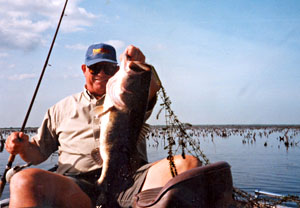 Chug Bug bass during low water.
Chug Bug bass during low water. |
Then along came Hurricane Gordon and smashed the tops of the trees in Stick Marsh and then when the water level dropped the fishermen had less places they could identify. So the bass got safer.
Then along came the St. Johns River Water Management District and raised the level of Stick Marsh and Farm 13. That gave the bass more water depth in which to hide. Then along came a series of Hurricanes that blew out the vegetation. Then the catching got tougher. Not so now.
I interviewed Bob Eisenhauer, Florida Wildlife Biologist, who has worked at Stick Marsh and Farm 13 almost since their inception. I have seen Bob on the water, at the ramp, and around the area. Bob has the best interest of the bass at heart. Bob is a bass fisherman as well. So, his information is ‘right on” when it comes to what the bass fisherman wants to know. The largest bass Bob can remember being electrofished (anglers call that shocking) is 12.5 to 13 lbs. Electrofishing only works around the perimeter of the lake. The results of electrofishing only can be related to the perimeter of the lake. The best part, fishing wise, about Stick Marsh and Farm 13 is that there is similar structure and cover off shore that holds bass. A biologist might not be able to relate electrofishing results along a perimeter to off shore populations but those of us with rods and reels can. Most of the bass catching at Stick Marsh and Farm 13 is done off shore. As far as big bass reported by anglers, reliable reports of several bass in the 17 pound range have been made. Then there are those questionable reports of 20 pound bass being caught. I do not doubt that there are multiple 20 pound bass swimming around Stick Marsh and Farm 13. I do doubt that anyone has caught one of them. I have not seen any photographic proof. I have had bass hooked by myself, several of my clients that have towed by Bass Cat around. I know of several bass over 30 inches long being caught. Those are long bass and that kind of length certainly has the potential of twenty plus pounds.
The lakes have changed over the years. That is part of the anatomy and history of a living lake. What has not changed is the catch rate and the electrofishing results. Less angler pressure might be the reason for a similar catch rate is one observation of Bob Eisenhauer. However, that does not change the results of electroshocking. The bass are in there and they have been in there. What is most interesting to me, as an angler, guide, and writer is that there seems to be an excellent spawn the last two seasons. Those year classes of bass seem to be stupid. They are extremely easy to catch and they are fat and full and looking good. Throw in one of those monsters now and then and the day is full of action.
With the bass that were reported caught during the Spring and the bass that my clients caught during the months of March and April I have no doubt that there was as excellent spawn this year and I know that there are lots of monster bass out there. There are lots of bass of a lifetime swimming around those two lakes.
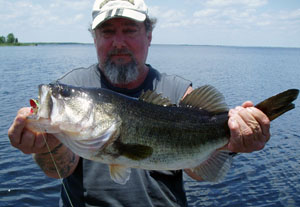 Hula Popper bass.
Hula Popper bass. |
Why so much emphasis on the vegetation. Bob brought it to my attention that the vegetation clears the water. The vegetation breaks down the wind effect on the lake and therefore makes keeping a boat in position to catch bass much easier. The lakes are fishing larger than they have in years and with the spreading vegetation they will continue to fish larger. Many of my clients continually remark about how healthy the bass are. The bass are fat, full and fight like the dickens. What ever they are eating they are eating lots of it. So..there must be lots of it to eat.
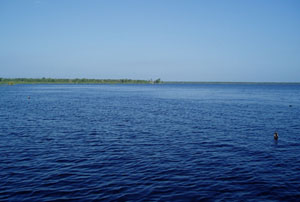 The smooth water is topped out eel grass in
The smooth water is topped out eel grass in
one of the grass beds. |
This summer has been mostly overcast. There have not been those days of high sky and high sun. The days of high hot sun cause the shad to come to the surface. Then the bass eat them up and anglers see the action and move in and catch the bass. Without the sun the shad have stayed below the surface. The shad are in the lake; they just are below the surface. So.. while the angler has had good fishing weather the weather to produce schooling fish that can be seen hasn’t been regular. When I questioned Bob about the shad population he told me that shad are not regulars on electrofishing as shad tend to live off shore.
Bob did tell me that the wild shiner population was reduced from the 90s. However, Bob went on to mention a couple of facts. First, it is normal for a new lake to have an exploding wild shiner population and then as time passes the wild shiner population decreases. I remember days when the “Koreans” catching wild shiners would catch 1200 wild shiners per boat with three boats out on the water. Their wild shiner catch was so good they used a Mercedes car to pull one of their boats. Also, Bob pointed out that wild shiners live in vegetation. When the vegetation left that caused a reduction in the wild shiner population. Well…can we say that more vegetation will increase the wild shiner population? I do! Bob further noted that the population of Seminole Killfish was greatly increased in recent years as compared to the 90s. The Seminole Killfish is not well known by most bass anglers. But I will gladly tell you that bass love them. They are easier for bass to eat than wild shiners because of their shape. I don’t think I could get enough Seminole Killfish to use as bait because the bass would eat them right up-right away-and come back for more.
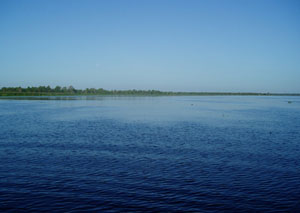 The smooth water is topped out grasses.
The smooth water is topped out grasses. |
The Biologists have made a couple of attempts to plant grasses in Stick Marsh and Farm 13. Those met with little success. They also placed fish attractors in the lakes. The value of those was for about a year. Mother Nature has done a job that no amount of tax payer dollars could do. Mother Nature has got some really pretty grass beds growing in Stick Marsh and Farm 13. We can credit those grass beds to water flow through the spillway from Garcia. However, that water has flowed for years without any growth. What ever caused the grass to grow- Thank You! Thank You! Thank You!
 Gary Clark with a large Chug Bug bass caught in August out of eel grass.
Gary Clark with a large Chug Bug bass caught in August out of eel grass. |
My interview with Bob Eisenhauer, basically, reaffirmed my belief that the bass have always been there; always will be there; and the only difference is the abilities of the anglers to catch them. One more thing: anglers do better catching when there is vegetation in the water. And now there is lots of vegetation. And there is more of it every day as it is growing. Oh, the biologists want the vegetation.
Don Willis moved to the area in 1996. Don’s memories of Stick Marsh include the catching of a 17 pound largemouth. Don doesn’t talk much about it, in fact, Don is sometimes afraid to talk about it. You see Don did not have a camera at the time. It is Catch and Immediate Release at Stick Marsh for largemouth bass so no one else saw the bass. Keep in mind that a 17 pound largemouth is probably within the top 250 largest ever caught.
Don, being new to bass fishing at the time did not realize how big the fish was in accordance to ordinary bass catches. Don has caught four bass over ten pounds so far this year (2013). He has not topped the seventeen pounder but, like all bass fishermen he is out there on a regular basis trying.
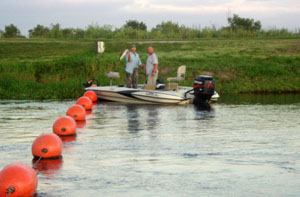 Spillway running water fishing
Spillway running water fishing |
 |
Don fishes Stick Marsh multiple times a week. He says he has no reason what so ever to fish any where else. Stick Marsh is the best place to catch numbers of bass, large bass, larger bass and numbers of larger bass.
When the water is running, usually the summer time, the bass move into the running water and feed on the schools of bait that have also moved into the running water. It is common to catch a hundred bass, and more, a day in the running water.
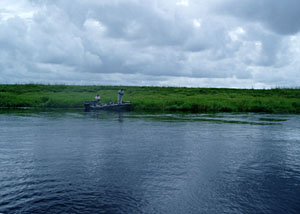 Crankbait John working the culvert current.
Crankbait John working the culvert current. |
John loves to fish a deep diving crankbait in the running water. John told me about catching a large number of bass over six pounds a day in the running including a ten pounder and a thirteen pounder. It is not uncommon for the large bass to move into the running water in schools. Catching multiple ten pounders in a day is highly possible at Stick Marsh.

Stick Marsh is a great place for young angler. |
The most ten pounders my clients caught in a day was five reports Hugh Crumpler III (myself), followed by four over ten in a day, followed by three over ten in a day (multiple times) and I have no clue how times my clients caught over two ten pound bass in a day.
The evidence is over whelming. If you want to catch large bass, number of large bass and number of bass the place to go is Stick Marsh. I moved here because of the bass fishing. I still live here because of the monsters in Stick Marsh. And with the vegetation coming on- hold on to your rods or the bass will take them away!
Over the years I’ve said it many, many times. And now I say it again: “It does not matter how good of a fisherman you are; if there are not any ten pounders in the lake you won’t catch one. The more ten pounders there are in a lake the better the chances of ANYONE fishing to catch one.” Stick Marsh and Farm 13 have a large number of large bass. The lakes are not that large. It is simple math. ANYONE’s chances of catching a large bass are OUTSTANDING at Stick Marsh. And, in my opinion, better than any place else in the world! According to Bob the Biologist Stick Marsh and Farm 13 are at the top of the lakes in Florida.
Don’t forget, it’s always best to stack the odds in your favor. That means good equipment, good bait, be it artificial or live, good information, and the use of good techniques.
LOCATION:
So where is this fantastic spot? Why doesn’t it get more publicity?
Stick Marsh and Farm 13 are on the East Coast of Florida. They are North of Fellsmere and South of Palm Bay. Palm Bay is the largest city in Brevard County. Palm Bay and Brevard County do nothing to promote Stick Marsh. Fellsmere is so small that they don’t need to promote Stick Marsh. Indian River County is actually the County where Stick Marsh and Farm 13 are located. Indian River County has taken some promotional efforts from time to time. But nothing serious. Fish and Wildlife didn’t promote the lakes. They were concerned that they might “over hype” the fishing. Which turned out to be impossible. Most of the promotion of the Stick Marsh and Farm 13 has been by guides and anglers who had the bass catching trip of a lifetime. While, I concentrate on bass, my favorite fish to catch, the crappie (spec) population is outstanding and could be said the same of as the bass population.
There is no place close to the lake to stay, lodge, eat, get supplies, basically nothing near the lake. So no one promotes the lake except a guide now and then, such as myself, who wants his clients and everyone else who wants to catch bass to know about the place. I have listed the closest places to lodge and get bait and tackle. Those that I have listed support the fishermen who go to Stick Marsh and Farm 13.
Many guides don’t want to make the trek from Orlando to guide at Stick Marsh because of the sand road, the expense of toting a boat, the possibility of “bumping” obstructions, and the time involved in the trek. However, for the client, for the person wanting to catch fish of a lifetime the trek is worth it. For me, and several others, it was worth moving close.
The North end of the lakes are in Brevard County and the majority of the water is in Indian River County. There is a line on the boat ramps indicating the county line. One lane of the ramp is in Brevard County and one lane of the ramp is in Indian River county. Just as a matter of trivia if anyone ever asks you who was the first one to use the paved ramp. It was Hugh Crumpler III. And a treat it was!
Lodging is available in Palm Bay and Melbourne.
A BASS PRO SHOPS is moving into Palm Bay. One of the reasons for the store is Stick Marsh. With Stick Marsh a mere 6500 acres the importance of Stick Marsh to bass fishing becomes evident with the fact that the Bass Pro Shops is moving a store to Palm Bay.
DIRECTIONS:
FROM THE NORTH: Take the Malabar/Palm Bay Exit off I 95. That is Highway 514. Go East to the first traffic light. That is Highway 507, also known as Babcock Street. Go South about 12 miles. You will cross a bridge that is curved to the right and slopes to the right. This bridge is over the C-54 Canal. RIGHT NOW, IMMEDIATELY at the end of the bridge is a sand road to the right. Take that sand round to the END. It is 6.4 miles and you will be at the boat ramp and parking lot.
FROM THE SOUTH: Take the Sebastian/Fellsmere Exit off I 95. That is Highway 512. Go West to into the town of Fellsmere. You will come to a BLINKING light. That is Highway 507. Go North. You will think you drove back in time as you drive through this part of town. Enjoy it. The road will come to a T intersection. Go left. This continues to be Highway 507. You will come to three way stop. Go right. This is still Highway 507. You are now going North. It is a straight drive. After a few miles you will cross a short bridge then there is a sand road on your left. GO LEFT NOW. Straight ahead is a bridge over the C-54 Canal that turns to the left and slopes to the left. If you cross this bridge you went too far. Go back to the sand road. It is 6.4 miles down the sand road to the ramp and parking lot.
NOTE: There is NOTHING on the lake. No restaurants. No pizza delivery. No marinas. No tackle stores. No houses. Bring what you need and take what you bring with you home. Bass stay in the lake except for the short time to takes for a few photographs. Catch and Release!
AVAILABLE LODGING:
BUDGET INN
4505 West New Haven Avenue
West Melbourne, FL 32904
321-724-5450
www.BudgetInnofMelbourne.Com
HAMPTON INN MELBOURNE
194 Dike Road
Melbourne, FL 32904
321-956-6200
www.Melbourne.HamptonInn.Com
HOLIDAY INN EXPRESS & SUITES
1206 Malabar Road SE
Palm Bay, FL 32907
321-220-2003
www.Hiexpress.com/palmbay
MOTEL 6
1170 Malabar Rd. SE
Palm Bay, FL 32907
321-951-8222
M61292bo@Motel6.Com
QUALITY INN
890 Palm Bay Road NE
Palm Bay, FL 32905
321-725-2952
palmbay@cphosp.com
BAIT & TACKLE
ELITE ANGLERS SERVICE
3200 Dixie Hwy
Palm Bay, FL
321-953-6444
STRIKE-ZONE FISHING
2771 West New Haven Ave.
Melbourne, FL 32904-3705
321-956-1122
GUIDE & CHARTER SERVICES
Hugh Crumpler’s
Florida Trophy Pro Bass Fishing (see his current report)
Palm Bay, FL 32909
321-626-6174
www.Hugh-Crumpler.Com
HughCrumpler3@gmail.com
About the Author
Hugh Crumpler is an avid bass angler. Hugh is a Professional Bass Angler and Professional Bass Guide. Hugh is also an author. Hugh has caught more than 460 bass over ten pounds and his clients have caught more than 1500 bass over ten pounds. Hugh authored a phamphlet in the early 70’s that is considered to be “historically significant”. Hugh has authored an ebook: MEMORIES OF AN OLD BASS FISHERMAN The Formative Years. With Hugh’s experiences, skills, and knowledge he brings to light the present fishing conditions at Stick Marsh and Farm 13.

